
Extraordinary, iconic, and unusual buildings; a collection of images from around the world
Japan 2018
Ainokura. In a remote valley surrounded by mountains are three historic villages. The Shirakawa-gō and Gokayama regions get the third-highest average annual snowfall in the world, so the traditional houses have very steep roofs. Most began life as simple farmhouses and many are still occupied. Walking through the villages I feel as if I’ve landed in a fairy tale or the setting for a fantasy novel about another world. The wood and thatch houses hug the land as if they have always been there, strong, stable, and comforting. They are surrounded by sweet gardens and an aura of love.

Tokyo. The mirror building, a shopping mall, is everything I’d expected from having seen a gazillion pictures of it on the Internet. It must be one of the most photographed buildings in Japan, and rightly so. It’s quite extraordinary. The entrance is a kaleidoscopic phantasmagoria, a tunnel of mirrors at all angles that creates a surreal fanciful hallucination, and if you look closely at the first photo down at the bottom on the right you can see the street.

Tokyo. The Audi Forum seems impossible. And perhaps it is. It was completed in 2006, but I notice that all the windows from top to bottom are draped inside with black plastic, and there is a railing across the front of it. Maybe they’re just renovating. I can’t find any recent information other than it’s reported on Yelp that the building is closed. Either way it’s one of the most unusual buildings I’ve ever seen, and is (was?) justifiably a noted Tokyo landmark.

Italy 2011
Italy is full of beautiful cathedrals, and we went to six of them, each spectacular in its own way. In Milan we had no idea! We were going to meet a friend. We hadn’t thought of the cathedral, or even really knew there was one, but we stepped out of the metro and there it was right in front of us – so unexpected and magnificent. We both went WOW! at the same time.
We made plans to meet friends in Orvieto for the day, arranging to meet in front of the duomo. We drove from Tuscany, but had no idea where the duomo was, so just kept driving, deeper into the town, up and up, over narrower and narrower roads, eventually following signs to the duomo. And suddenly there it was. Right in front of us. It took our breath away with its completely unexpected grandeur and beauty.
India 2012
Jama Masjid is the biggest mosque in Delhi. It was built in the 1650’s at a cost of one million rupees. It has three great gates and two 40-metre high minarets constructed with strips of red sandstone and white marble. The courtyard can accommodate more than 25,000 people. It’s a very imposing building, which, as with most religious buildings, seems to be the point.
Agra. The Taj Mahal is a white marble mausoleum commissioned in 1632 by the Mughal emperor Shah Jahan to house the tomb of his favourite wife; it also houses the tomb of Shah Jahan himself. The opening photo was taken in the evening light from across the river behind it. Even the main gate is spectacular!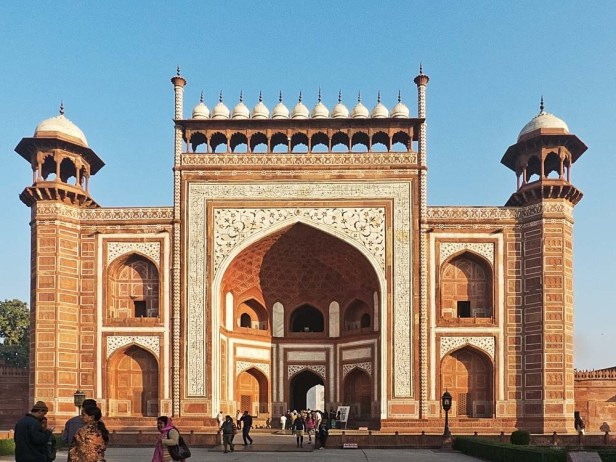
And the mausoleum itself? It is as beautiful and magnificent as all the hype; a resplendent offering to love.
Jaipur. The Amber Fort and palace was commissioned by one of the Rajput Maharajas in the late 1500’s with successive rulers adding to it. One of the Maharajas apparently had 25 wives, 60 “girlfriends” and 150 children. It reminds me of one of the Chinese emperors who literally died of too much of a good thing. Either way this fort and palace is a pretty spectacular legacy of the times. To give you an idea of the size those tiny bits of colour on the far right of the photo are elephants going up the ramps.
Vietnam 2013
Cao Dai is a Vietnamese religious movement that incorporates aspects of Buddhism, Taoism, Confucianism and Catholicism. Their aim is for universal peace and harmony. Their Great Temple, about an hour from Ho Chi Minh City is a wonder to behold. So is their daily service complete with chanting and traditional Vietnamese music. And they’re willing to let hoards of tourists wander through the entrance halls and upper balconies during the service. It was riveting. I’ve never seen anything like it.

Myanmar 2013
This is Karaweik Palace, a major Yangon landmark. It was built from 1972 to 1974 so it’s not some ancient archaeological wonder, just a modern fantastical wonder. The building mainly contains a buffet served with traditional dance performances. We wanted to go but it was fully booked.
On our last evening in Bagan we climbed, just before sunset, to the top of one of the biggest pagodas. In every direction thousands of pagodas dot the landscape as far as the eye can see. So many of them! The mind can hardly take it in; the sheer numbers and scale of it. For about 250 years, between the 11th and 13th centuries, the rulers and wealthy subjects of the Bagan Empire built over ten thousand pagodas, temples and monasteries. Mainly due to earthquakes “only” something over two thousand remain. Well let me tell you, two thousand is plenty! Two thousand is mind-boggling. They dot the landscape like something from another world, both insistent and ethereal.

At the Phaung Daw U Pagoda at Inle Lake there are five lumpy gold Buddha’s, sitting in the middle of a big “stage”. Men have been placing so much gold leaf on them for so long, in prayer, supplication, devotion, hope, yearning, reverence, and maybe even in surrender, that the original forms are no longer recognizable. They are lumpy piles of gold, in a splendiferous setting complete with whirling and flashing lights and beautiful altar offerings. If you google Phaung Daw U Pagoda there’s plenty about the lumpy Buddhas and about a festival the pagoda is host to, but little about the building itself.
Turkey 2015
We wander for hours in searing heat around the ancient ruins of Ephesus, a city that was once second only to Rome. There is much that we take for granted that they also had – glass containers, ceramics, indoor heating, complex water systems for homes and fountains, even public toilets. I’m always astonished by how advanced ancient civilizations were. The greatest treasure of Ephesus is the magnificent Celsus Library. It once held twelve thousand scrolls and was the third largest ancient library. We are suitably impressed by its magnificence, grand beauty, and cool interior.
Istanbul. The Basilica Cistern is an enormous underground reservoir built in 532 CE as a water storage system. Three hundred and thirty-six marble and granite columns, nine-metres high, support the domed roof; it has the capacity to store 100,000 tons of water, which was transported via aqueducts from a forest nineteen kilometres away. We have no idea what to expect. We descend into an eerie golden darkness. As our eyes adjust to the light we see before us a cavernous space, multiple soaring columns and a rich orange light, all of which is reflected in the water. The whole effect is startlingly beautiful.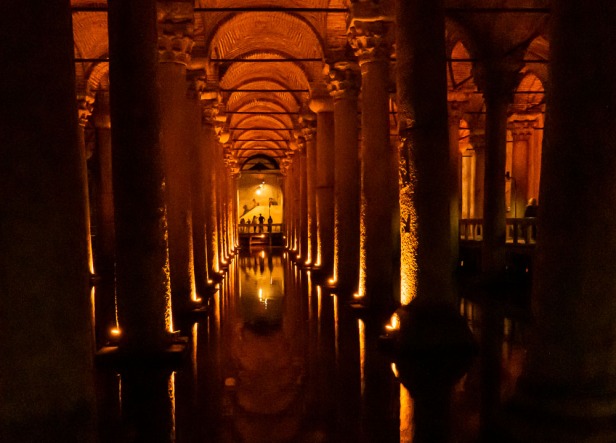
The Suleymaniye Mosque sits atop one of Istanbul’s seven hills, dominating the skyline, an unmistakable iconic landmark for the entire city. Commissioned by Suleiman the Magnificent, it was built in the 1550’s, and although it is not the biggest of the Ottoman mosques, I am still impressed by its size and splendour. The interior is one of golden spaciousness and soaring beauty.
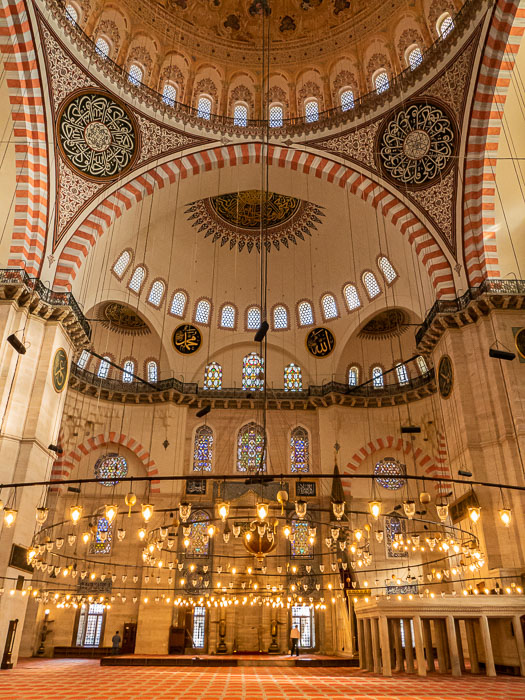
The Byzantine cathedral of Ayasofya is the most visited tourist attraction in Turkey. In all of Turkey. In popularity it outranks all other museums, Topkapi Palace, Ephesus, the Blue Mosque, and the extraordinary landscapes of Cappadocia and Pamukkale. It was built 1500 years ago as an Eastern Orthodox cathedral in what was then Christian Constantinople. Its dome is second only in size to the Pantheon in Rome and soars 55 metres (180 ft) above the marble floor. It is truly epic in size; unfortunately the interior has the sad feeling of grimy neglect.
Sultanahmet Camii is known as the Blue Mosque because of the hand-made blue tiles covering the walls of the interior. We enter a huge, silent, and serene space. It is overwhelming in its beauty, comparable to any of the grand temples and cathedrals of the world. There are only a few people inside when we first enter, and in such an enormous space it feels as if we have the place to ourselves. I stand awed, slowly taking in the spacious whole, and the gorgeous details. Light streams in through the many stained glass windows. It is glorious.
Jordan 2015
Petra. After walking two kilometres through a narrow canyon we finally emerge into an open space. Al Khazneh, known as the Treasury, stands before us with its clean Hellenistic lines. It is like an epiphany, and surely the most spectacular and astounding sight in all of Jordan. The Treasury, carved directly from the rock, was the tomb of King Aretas III, and displays the extraordinary engineering skills of the Nabataeans, an industrious Arab people who settled in the area more than two and a half thousand years ago.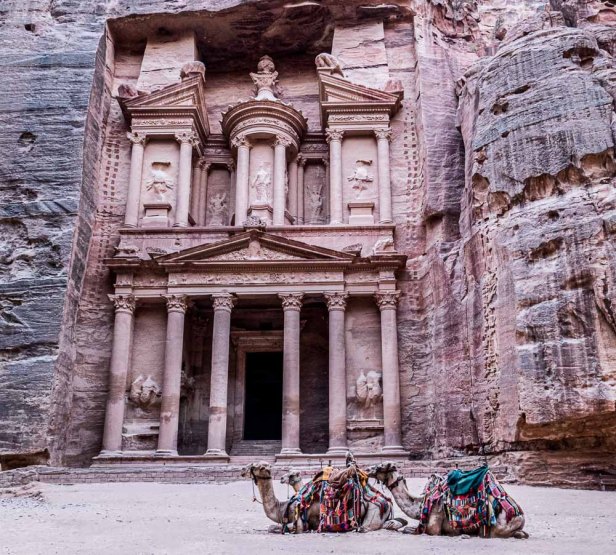
There is an ageless rock-cut path of more than eight hundred steps, the processional route to The High Place of Sacrifice of this ancient civilization. It leads up in the hills where the views are glorious, and where the Ad-Deir Monastery is hidden away. It is one of the great monuments of Petra, another grand Nabataean tomb, similar in design to the treasury but much bigger.
Egypt 2015
Luxor is the Egyptian city that lies atop the ancient city of Thebes. From about 1500 to 1000 BCE it was one of the most spectacular cities in Egypt. Its big draw today is the great temple at Karnak, which I still remember learning about in art classes in school, and was thrilled to finally see in person. Pictured, Luxor Temple, which was built to celebrate ancient Egypt’s Opet Festival, was connected to Karnak by an avenue of 700 sandstone sphinxes, many of which still survive.
Mexico 2016-17
The magnificent pyramid of Kukulcan, the serpent god, is the most iconic structure at Chichén Itzá, and dominates the site. It was used for religious ceremonies including human sacrifice. The Maya believed that the sacrificial victim would bypass the dark and treacherous underworld and thus be able to go directly to Tamoanchan, a place of misty sky and beautiful flowers. I guess the promise of heaven made it a little easier on the victim.
In marked contrast to the ancient pyramid of Chichen Itza is La Parroquia de San Miguel Arcángel, the parish church of San Miguel de Allende. Its soaring pink towers dominate the town square. Zeferino Gutiérrez, a stonemason with no formal training in architecture, designed the towering pinnacles in the late 19th century. Apparently he based his design on a postcard image of a Belgian gothic church, and instructed his builders by scratching plans in the dirt with a stick. What he created must be one of the most beautiful and magical churches in the world.
Thanks to Toff Bolton, who commented on the post Just One Person for the suggestion to do this post. I have so many buildings to share that in a few weeks I’ll do a second post.
*Frank Lloyd Wright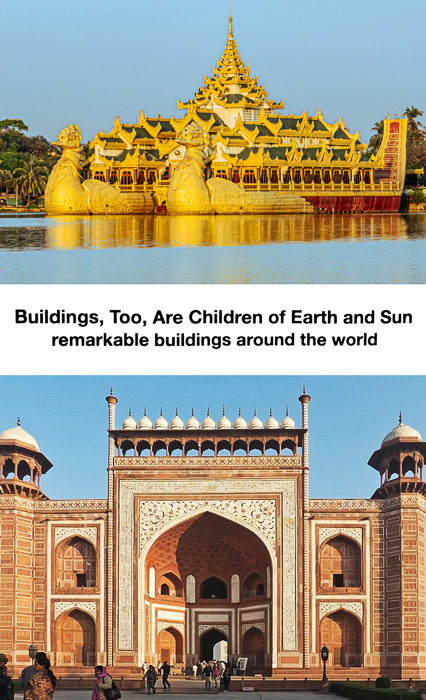

Next post: Vancouver urban wildlife – coyotes, racoons, squirrels, herons, and much more.
All words and images by Alison Louise Armstrong unless otherwise noted
© Alison Louise Armstrong and Adventures in Wonderland – a pilgrimage of the heart, 2010-2021.

Stunning set Alison!
LikeLiked by 2 people
Thanks so much Cindy
Alison xo
LikeLike
There are some beautiful buildings on this list. My favourites – that I have seen in person – are the Taj Mahal, the Blue Mosque and Chichen Itza Temple. Great list – I wouldn’t mind seeing Sydney Opera House on your list!
LikeLiked by 1 person
Thanks so much Sharyn. I grew up in Australia at the time the opera house was being built. The cost over-run was a huge controversy, and they had to hold a lottery to fund it. Anyway I’ve been there numerous times both when I lived in Oz and on trips back home. I have a photo somewhere, but not sure where. I’ll see if I can dig it out and put it on the next instalment. I know it’s become one of the world’s iconic buildings so should be included.
Alison
LikeLike
I loved this roundup, Alison, and I’m excited to see what buildings you will be featuring in Part 2. True to form, you captured both the old and the new in Japan – those zany futuristic structures in Tokyo make for a stark contrast to the timeless and deeply traditional farmhouses of Ainokura. Your swoon-worthy photos from Petra also struck a chord. My last long-haul trip before the pandemic was to Jordan; I’ll never forget the experience of coming face-to-face with the Treasury and the Monastery after reading about Petra since I was a kid.
LikeLiked by 1 person
Thanks so much James. I was pretty blown away by those two modern buildings in Japan – zany is right! And visiting those traditional villages in Japan was definitely a highlight. As was Petra! What an amazing place that is! Human beings can be so creative!
Alison
LikeLiked by 1 person
What a beautiful collection of buildings from around the world. I love the mix of modern and classic buildings you included. I was glad to see the Red Fort on here since so many people just see the Taj Mahal. I hope the window has not closed for us to see the buildings of Myanmar!
LikeLiked by 1 person
Thanks so much Linda. I’m glad you enjoyed the selection. Some of those forts in India, especially in Rajasthan, are quite amazing. We went to 2 or 3 of them.
Oh I do hope you are able to get to Myanmar. It was definitely a highlight for us.
Alison
LikeLike
What an incredible collection, Alison. It certainly represent your and Don’s world travels. And makes me jealous. Grin. Fortunately I have seen three of them. –Curt
LikeLiked by 1 person
Thanks so much Curt. It was such a lovely trip putting this collection together, really highlighting how much we’ve seen and done. As we sit on the couch in Covid-times it’s nice to be reminded. Which 3?
Alison
LikeLike
I’m loving all these incredible images. Such beautiful architecture!
LikeLiked by 1 person
Thanks so much Jen. I’m glad you liked it.
Alison
LikeLike
We humans sometimes do magnificent things. Thanks for the reminder.
LikeLiked by 1 person
My pleasure. I too need to be reminded from time to time. We *can* do magnificent things!
Alison
LikeLiked by 1 person
Love this, Alison, as you include some ancient monuments I’ve been yearning to visit: the pyramid of Kukulcan, Taj Mahal, the temple at Karnak, and Milan’s Duomo. There’s just something about magnificent structures that are hundreds and thousands years old. They always make me wonder how life was like for the people who built them, and how these massive places of worship were used during their heyday.
LikeLiked by 1 person
Thanks so much Bama. The four you mention are all definitely worth seeing, and I hope you get to them. I too wonder about those that actually built the ancient buildings, and about life in those ancient times, and I’m always surprised to discover how advanced they were (though I don’t know why I should be). Apparently the ancient temples of Egypt were painted in really bright colours! I’d love to have seen that!
Alison
LikeLiked by 1 person
Such amazing buildings to be found all over the world. Every time I see a fabulous, breathtaking building, I think I have seen the best, then I see another one…
LikeLiked by 1 person
Oh I do agree! There are so many that take your breath away, and we’ve seen only a tiny fraction of them, and still I’ve had to spread the collection over two posts. We humans can be pretty clever sometimes, and create great beauty.
Alison
LikeLike
An incredible grouping of buildings Alison. In some cases you transported me back to fabulous trips of our own, Turkey, both in Ephesus and Istanbul, Petra and Mexico. However of all of the memories your beautiful post stirred, the most vivid was in Orvieto. We were on a cycling tour and Dave and I rode our bikes over to the cathedral before our riding began one morning. We were completely alone as the sun began to touch the building. I can still feel the cool air and the sense of wonder having the architectural beauty all to ourselves.
LikeLiked by 2 people
Thanks so much Sue. I’m glad I took you back through some good memories. I love travel (and blogging about it!) for that. I can’t imagine how magical it must have been to see Orvieto Duomo that way! Even for us in broad daylight it was pretty amazing – driving along a narrow road, turning a corner and there we were, in the square looking straight at it. Socks knocked off!
Alison
LikeLiked by 1 person
That is a wonderful selection of buildings there! Buildings are a testament to human ingenuity. I also love how every city in the world has a unique skyline
LikeLiked by 1 person
Thanks so much winterose. They *are* a testament to ingenuity. And to vision and creativity. We can be so clever sometimes.
Alison
LikeLike
Yes, I do hope there is a trend to creative and sustainable buildings too
LikeLiked by 1 person
I enjoyed your collection of all these beautiful buildings from around the world. They are all unique, from the most ancient to the modern ones. Of course I was glad to see the Pyramid of Kukulcan included, but they are all just wonderful. Gorgeous photos!
LikeLiked by 1 person
Thanks so much Emese-Réka. I’m glad you enjoyed it. I really wanted to include a variety, and of course Kukulcan had to be chosen! The whole site of Chichen Itza is quite amazing. We made sure to get there really really early before the tour buses.
Alison
LikeLike
Such a wonderful collection!!
LikeLiked by 1 person
Thanks so much Christie.
Alison
LikeLiked by 1 person
Wow! What an amazing post, beautiful photos & spectacular buildings. There are many here that I haven’t seen but you have certainly given me the inspiration to visit. I love the fact that you have modern architecture mixed with these iconic ancient monuments. Looking forward to your second instalment now too!
LikeLiked by 1 person
Thanks so much Sue. I had so much fun going through old photos and putting this post together. There are so many amazing buildings in the world. I’m glad I’ve inspired you to go visit some of them – when we can . . . . .
Alison
LikeLike
Great idea for a post Alison! I have seen so few of these buildings in real life, with the exception of those in Egypt and Turkey. Stunning! There is something about the symmetry of the Delhi mosque and the Taj that I find tremendously appealing. The ones that immediately spring to mind for me are Barcelona’s Sagrada Familia and Granada’s Alhambra (guess I’m thinking of sunny Spain).
LikeLiked by 1 person
Thanks so much Caroline. Well Egypt and Turkey is a pretty good start! The symmetry appeals to me too, but then I look at something like the Audi Forum and am blown away by the mind-boggling crazy of it. I don’t like it to look at, but I sure appreciate the creativity. I’m sooo glad you mentioned Alhambra. I have Sagrada Familia lined up for the next post, but had completely forgotten about Alhambra so will def include that too now.
Alison
LikeLiked by 1 person
Aaaah. Your wildlife and people pictures are wonderful, but buildings – buildings are my thing. Places, in particular, which include buildings. A wide variety here, well worth the tour. I kept thinking “surely that’s the last set. What else is left?”
I’m so jealous that you’ve been to Ephesus. I just read about Ephesus in this book called the Map of Ideas, all about how the knowledge of ancient Greece was preserved after the fall of Rome until the Renaissance. Ephesus was a happening place!
LikeLiked by 1 person
Thanks Felicity. I’m glad you enjoyed the previous posts, and I’m glad I’ve now done one about your favourite thing! There are many more to come in the next “buildings” post (in a few weeks I think) – Gaudi’s many masterpieces, Alhambra, a lesser known govt building in Malaysia, the Forbidden City, Notre Dame, Sacre Coeur, and many more.
Ephesus is pretty amazing. I hope you get there one day.
Alison
LikeLike
Your post is a great reminder to everyone what humans are capable of before the advent of technology and scientific evolution. The fact that some of the monuments such as the Taj Mahal dates back to the 17th century is a genius in itself! Each building listed in the post is nothing less than a miracle. The interiors of Cao Dai of Vietnam resembles like a beautiful painting! The Audi Forum of Tokyo is magic. Thanks for this enriching post! Loved each detail and the history behind it.
LikeLiked by 1 person
Thanks so much Kritika. My pleasure. I’m glad you enjoyed it. I agree each is some kind of miracle. Humans are capable of so much. Sometimes we forget that I think.
And yes, the Taj Mahal is pure genius.
Alison
LikeLike
I knew I shouldn’t come here for you’d make me very jealous, Alison 🙂 🙂 The prayers in Ho Chi Min and the peace of Bagan are such wonderful contrasts.
LikeLiked by 1 person
Awwww sorry Jo 🙂 It was such treat to put this post together, going back through files and memories. Don and I were both reminded of so many adventures, and of how lucky we are. The temple in Ho Chi Minh was such a wondrous surprise, and Bagan just look our breath away.
Alison
LikeLike
🤗💕
LikeLiked by 1 person
I loved this architectural tour, Alison. Your images are fantastic. The Taj Mahal, the Great Temple at prayer, Bagan, Orvieto – (and all the others) such magnificent beauty around the world. Thank you!
LikeLiked by 1 person
Thank you so much Jane. It was so much fun putting this post together. I had no idea I had so many photos of buildings that were worth sharing. That classic shot of the Taj I hadn’t even included in my original post about that visit! I loved going through all the old files for hidden gems. I’m glad you enjoyed it.
Alison
LikeLiked by 1 person
It is fun to group photos in different themes, which you do beautifully. It is fun to rework and revisit images from the past-a perfect pandemic activity. 🙂
LikeLiked by 1 person
I also visited and walked around a good half of these remarkable places built by communities putting together their best knowledge to build what they could conceive to be the most beautiful. How fortunate we are today to be able to go and admire these works that were originally intended for a smaller audience.
LikeLiked by 1 person
We are indeed fortunate. There’s so much to love about being able to travel in this age (pre-covid of course): being able to see different landscapes and cultures and wildlife. And for me seeing buildings like these is very much a part of it, reminding me of how amazingly creative and ingenious we are. It’s part of the best and most beautiful of humanity.
Alison
LikeLiked by 1 person
Uwe and I have been to some of these spots and you are so right that they’re children of the earth and sun. Your descriptions are wonderful.
LikeLiked by 1 person
Thanks so much Jadi. I’m glad you enjoyed it. There are so many amazing buildings around the world. We humans are capable of some pretty incredible things.
Alison
LikeLike
Marvelled by the architectural brilliance of these impressive buildings. It’s like gems from various corners of the globe! Starting from the wood and thatch houses in remote valleys of Japan to the sophisticated and grand mirror building in the same county talks about the diverse distinctiveness the world is made up of. Am awestruck with the architectural brilliance of each wonder listed in your post. It’s a post to be relished even a few centuries from now as most of the monuments dates back in times as early as 1500 BC. Such great treasures all in one post! Great research and rewarding!
LikeLiked by 1 person
Thank you so much Kritika. I’m so glad you enjoyed it. I had a wonderful time putting this post together – going through all my photos and being reminded of all the amazing places I’ve seen. I have another post of buildings to come. We human beings at our best are so clever and creative and extraordinary, and create extraordinary things.
Alison
LikeLike
Buildings are the foundations of the many and varied cultures across the globe.
LikeLiked by 1 person
Yes indeed. Buildings say so much about a culture.
Alison
LikeLike